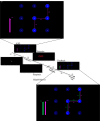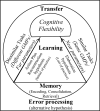Neural Mechanisms of the Contextual Interference Effect and Parameter Similarity on Motor Learning in Older Adults: An EEG Study
- PMID: 32595488
- PMCID: PMC7304442
- DOI: 10.3389/fnagi.2020.00173
Neural Mechanisms of the Contextual Interference Effect and Parameter Similarity on Motor Learning in Older Adults: An EEG Study
Abstract
The purpose of this study was to investigate the neural mechanisms of the contextual interference effect (CIE) and parameter similarity on motor learning in older adults. Sixty older adults (mean age, 67.68 ± 3.95 years) were randomly assigned to one of six experimental groups: blocked-similar, algorithm-similar, random-similar, blocked-dissimilar, algorithm-dissimilar, and random-dissimilar. Algorithm practice was a hybrid practice schedule (a combination of blocked, serial, and random practice) that switching between practice schedules were based on error trial number, ≤33%. The sequential motor task was used to record the absolute timing for the absolute timing goals (ATGs). In similar conditions, the participants' performance was near ATGs (1,350, 1,500, 1,650 ms) and in dissimilar conditions, they performed far ATGs (1,050, 1,500, 1,950 ms) with the same spatial sequence for all groups. EEG signals were continuously collected during the acquisition phase and delayed retention. Data were analyzed in different bands (alpha and beta) and scalp locations (frontal: Fp1, Fp2, F3, F4; central: C3, C4; and parietal: P3, P4) with repeated measures on the last factor. The analyses were included motor preparation and intertrial interval (motor evaluation) periods in the first six blocks and the last six blocks, respectively. The results of behavioral data indicated that algorithm practice resulted in medium error related to classic blocked and random practice during the acquisition, however, algorithm practice outperformed the classic blocked and random practice in the delayed retention test. The results of EEG data demonstrated that algorithm practice, due to optimal activity in the frontal lobe (medium alpha and beta activation at prefrontal), resulted in increased activity of sensorimotor areas (high alpha activation at C3 and P4) in older adults. Also, EEG data showed that similar conditions could affect the intertrial interval period (medium alpha and beta activation in frontal in the last six-block), while the dissimilar conditions could affect the motor preparation period (medium alpha and beta activation in frontal in the first six-block). In conclusion, algorithm practice can enhance motor learning and optimize the efficiency of brain activity, resulting in the achievement of a desirable goal in older adults.
Keywords: EEG; contextual interference effect; motor learning; older adults; optimal error; parameter similarity.
Copyright © 2020 Beik, Taheri, Saberi Kakhki and Ghoshuni.
Figures








Similar articles
-
Algorithm-Based Practice Schedule and Task Similarity Enhance Motor Learning in Older Adults.J Mot Behav. 2021;53(4):458-470. doi: 10.1080/00222895.2020.1797620. Epub 2020 Jul 23. J Mot Behav. 2021. PMID: 32703098 Clinical Trial.
-
Contextual Interference Effects on Approach Motivation When Learning Timing Tasks: A Frontal Electroencephalography (EEG) Alpha Asymmetry Study in Older Adults.Percept Mot Skills. 2022 Aug;129(4):1321-1341. doi: 10.1177/00315125221098325. Epub 2022 May 5. Percept Mot Skills. 2022. PMID: 35511777
-
Challenge to Promote Change: The Neural Basis of the Contextual Interference Effect in Young and Older Adults.J Neurosci. 2018 Mar 28;38(13):3333-3345. doi: 10.1523/JNEUROSCI.2640-17.2018. Epub 2018 Feb 26. J Neurosci. 2018. PMID: 29483284 Free PMC article.
-
Practice schedules for surgical skills: the role of task characteristics and proactive interference on psychomotor skills acquisition.J Surg Educ. 2013 Nov-Dec;70(6):789-95. doi: 10.1016/j.jsurg.2013.06.014. Epub 2013 Aug 6. J Surg Educ. 2013. PMID: 24209657 Review.
-
Repetition and variation in motor practice: A review of neural correlates.Neurosci Biobehav Rev. 2015 Oct;57:132-41. doi: 10.1016/j.neubiorev.2015.08.012. Epub 2015 Aug 21. Neurosci Biobehav Rev. 2015. PMID: 26299808 Review.
Cited by
-
Enhancing perceptual, attentional, and working memory demands through variable practice schedules: insights from high-density EEG multi-scale analyses.Cereb Cortex. 2024 Nov 5;34(11):bhae425. doi: 10.1093/cercor/bhae425. Cereb Cortex. 2024. PMID: 39503244 Free PMC article.
-
High contextual interference improves retention in motor learning: systematic review and meta-analysis.Sci Rep. 2024 Jul 10;14(1):15974. doi: 10.1038/s41598-024-65753-3. Sci Rep. 2024. PMID: 38987617 Free PMC article.
References
-
- Battig W. F. (1966). Evidence for coding processes in “rote” paired-associate learning. J. Verbal Learn. Verbal Behav. 5, 177–181.
-
- Brady F. (1998). A theoretical and empirical review of the contextual interference effect and the learning of motor skills. Quest 50, 266–293.
LinkOut - more resources
Full Text Sources
Miscellaneous

